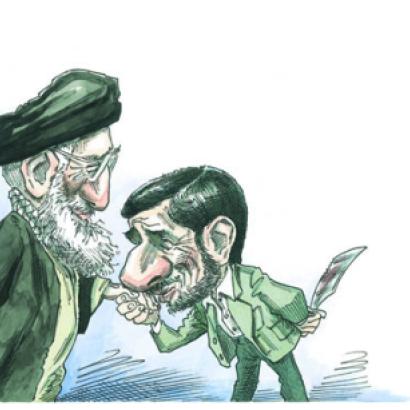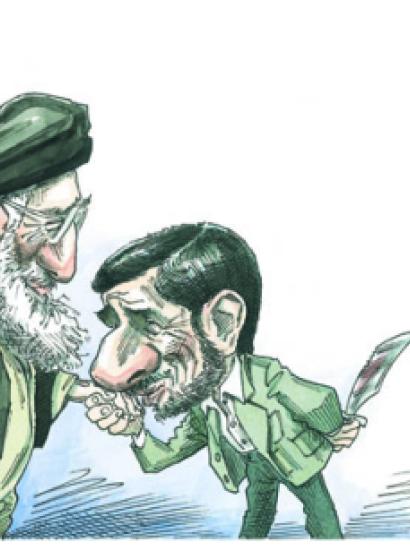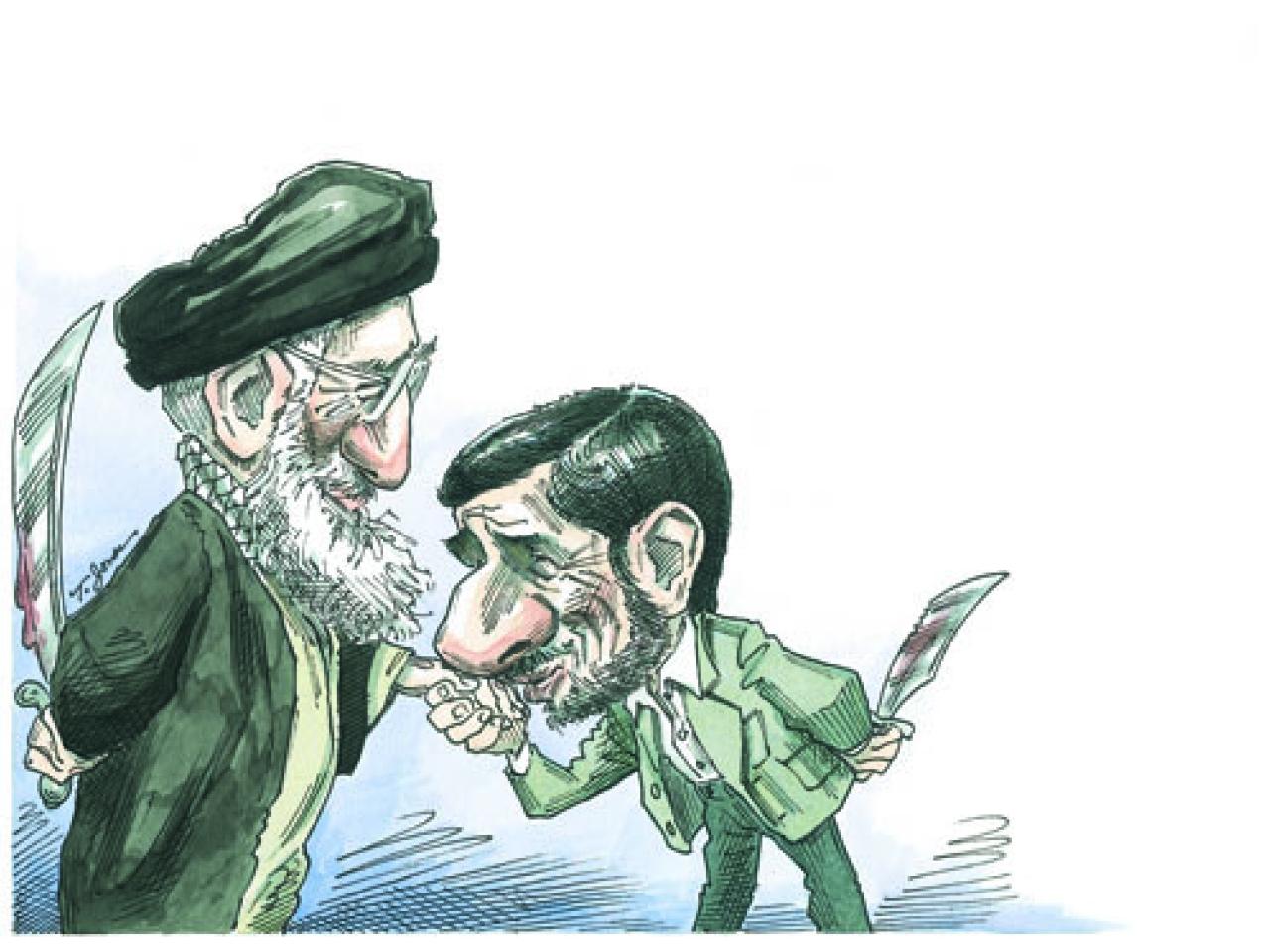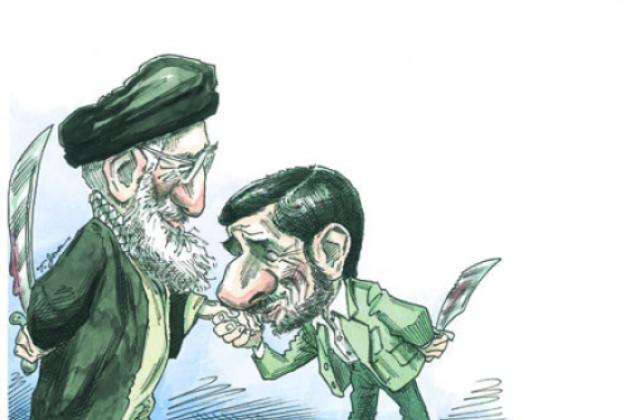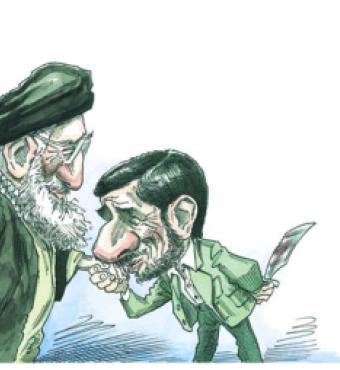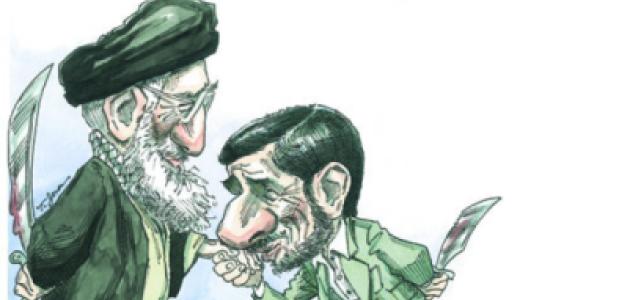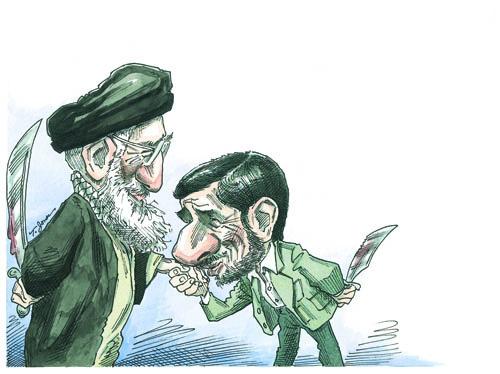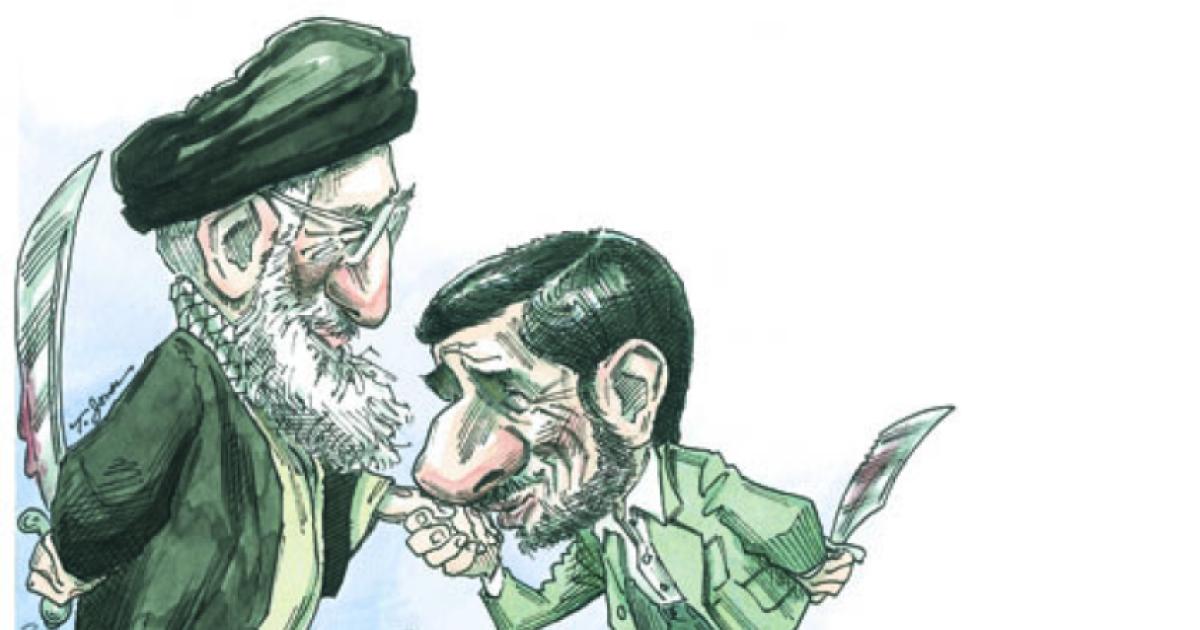- Energy & Environment
- World
- Contemporary
- International Affairs
- US Foreign Policy
- History
Mahmoud Ahmadinejad and his oligarch cronies have been having a rough time. The ayatollah is out for blood, and those in “elected” office are under attack. In fact, the dominant narrative taking over the Islamic Republic has at times sounded a great deal more like the magical realism of Gabriel García Márquez than the realpolitik of Hans Morgenthau. It has reflected months of bizarre allegations of voodoo and venal sins taking place in the offices and homes of the president’s closest aides and confidants—not to mention the more run-of-the-mill charges of financial corruption and sweetheart deals in places like Belarus. It has been a time of repeated open threats of the president’s impeachment—the same president who was not too long ago the darling of Ayatollah Ali Khamenei, close as he was to the supreme leader’s ideas and ideals. It has been a time when more than a hundred members of Iran’s parliament, the Majlis, have requested an investigation into the most recent presidential election and the allegation that 9 million votes were purchased by government cash.
Amazing how the tables can turn. Lest we forget, Mir Hussein Moussavi (the “losing candidate” in that same presidential election), his wife, Zahra Rahnavard, Mehdi Karroubi (the other “losing candidate”), and his wife, Fatemeh, have been under house arrest for months—for making the same accusations of fraud. Thousands of Iranians have been imprisoned, and about a hundred of the regime’s past ministers, deputy ministers, and directors were put on Stalinist-era-like show trials to confess to the crime of alleging a bought-and-paid-for vote. Hundreds of young women and men were tortured, dozens raped, and thousands forced into exile for questioning the June 2009 presidential election results.
And the months have been filled with charges of an even broader American-Zionist conspiracy. Naturally, they are the real masterminds behind the recent crisis, placing their “infiltrators” in the president’s entourage. The public has been told not to be fooled when the Western media or governments try to use these reports of voodoo, exorcism, and demonic powers in the Iranian president’s office against the clerical regime; a high-ranking official close to Khamenei announced that while these heresies were rampant and unacceptable among Ahmadinejad’s confidants, it should be remembered that the U.S. military has been tapping into such demonic forces for decades. European militaries have also begun emulating America in the use of the devil’s powers, he opined.
For much of last spring, Ahmadinejad and the Iranian regime stood on the edge of a political precipice. In early May, a commander of the Islamic Revolutionary Guards Corps (IRGC) predicted that forces loyal to Ahmadinejad, now called by their adversaries “the deviationist line”—yet another reminder of Stalinist- and Maoist-era monikers and purges—would “stand up” to the regime, creating a far greater threat to the country than the instability circa June 2009, when an estimated 3 million people in Tehran came out to protest what they considered a fraudulent election. Another IRGC commander predicted “a bloody year” ahead. The president was attacked by much of the regime’s vast propaganda machine, portrayed at best as a gullible dupe. He is surely “possessed,” declared the Ayatollah Mohammad Taghi Mesbah-Yazdi, Ahmadinejad’s onetime guru and spiritual guide.
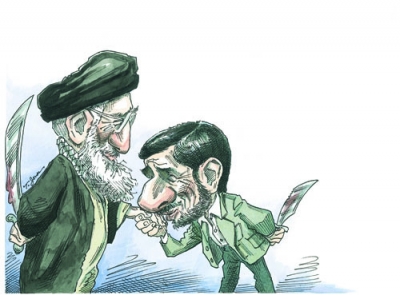
As spring ended, the pressure on Ahmadinejad increased. He chose at least a temporary retreat, agreeing to humiliate himself by appearing on television and reassuring the nation that he is a docile soldier of the supreme leader. Yet even that was not enough to create at least the appearance of a truce: no sooner had Ahmadinejad performed his act of public contrition and reaffirmed his “father-son-like” relationship with Khamenei than the ayatollah’s representative to the IRGC attacked the president for his unsatisfactory formulation of fealty. Your relationship with the supreme leader, Ahmadinejad was reminded in a tone of reprimand, is not one of a son to a father but of a mere follower to a saintly leader.
Since then, many among Ahmadinejad’s close circle of friends and allies have been arrested and interrogated. A prominent Friday-prayer leader (all of whom have great influence as religious figureheads—their statements would normally be read as the words of the supreme leader himself) announced that these arrests and interrogations had taken place on Khamenei’s direct orders. The supreme leader’s press office, however, declined to confirm this. According to rumor, the arrestee accused of being the president’s chief devil conjurer confessed to receiving his demonic powers only after desecrating a copy of the Quran. When websites reported that the unlucky disciple of the devil had been condemned to ten consecutive hangings, another site, this one close to Ahmadinejad, indicated its support for the punishment—one more sign the president was willing to make tactical retreats to cling to power.
The only indication of some respite in this stranger-than-fiction fight has been the declaration of a prominent member of parliament that the supreme leader now seems inclined to allow Ahmadinejad to serve out his term—only, of course, if he mends his ways, rids himself of his unsavory aides, and accepts his role as a mere foot soldier in the divine deliberations of the ayatollah. Ahmadinejad supposedly has two years left in office. As things stand, it is unlikely that he will make it that long. And if at the end he is still somehow president, Ahmadinejad will surely be but a shell of the bombastic, combative, feverishly messianic persona he created for himself before the crisis began.
DIABOLICAL CONTRADICTIONS
What is going on in Iran? Is it simply a battle over turf and ego, oil money, and the perks of power, or is there something more structural, even historical, behind this sudden emergence of tension between the supreme leader and his handpicked two-term presidential choice?
There is a deep incongruity in the Islamic Republic’s body politic: the mix of the modern republican principle of popular sovereignty (and the election of a president by the people as the embodiment of this republicanism) with the medieval notion of velayat-e-faqih, absolute personal despotism allegedly anointed by God and altogether independent of any need for the public’s support or votes. The forced marriage of these two mutually discordant ideals was the result of the 1979 revolution gone awry.
Democratic in nature and aspiration, the 1979 revolution was itself the result of a historic crisis of leadership faced by the institution of absolutist monarchy in Iran. Mozaffar ed-Din, in power from 1896 to 1907, saw the writing on history’s wall and signed a decree that gave up all the powers of an absolutist ruler; he agreed instead to become a constitutional monarch, modeled on the Belgian system in which the king’s powers were curtailed by a constitution and a parliament. Not long afterward, though, another absolutist, albeit modernizing, monarch came to power, creating the Pahlavi dynasty in 1925. The 1979 revolution that finally ended the Iranian royal tradition was launched to protest the second Pahlavi monarch’s usurpation of absolutist prerogatives.
That revolution was hijacked by Ayatollah Ruhollah Khomeini, who cleverly and disingenuously used it to implement his peculiar theory of clerical dominance. Then, as now, a majority of Shiite ayatollahs reject this notion, suggesting instead that only upon the return of Shiism’s Twelfth Imam—believed to be in hiding, or occultation, until the apocalyptic day when he will emerge and usher in a just and perfect society—can a true Islamic state be created. And only an infallible imam can lead such a state, as its rules and commands are divine, absolute, and incumbent on every citizen. Khomeini, on the other hand, suggested that the clergy could seize power anytime the occasion allowed. Thus in the constitution, inspired partially by his ideas, a disproportionate share of authority was placed in the hands of the unelected supreme leader.
At the same time, as a nod to the democratic nature of the revolution, the constitution made space for a presidency in charge of the executive branch, elected by direct popular vote, and a legislature, also brought into office by the will of the people. When Khomeini eventually took charge, the incongruent constitution, giving him the lion’s share of the power, was passed. This arrangement was in direct breach of the often-repeated social contract Khomeini offered the citizens of Iran in 1978, when he was jockeying to lead their democratic movement. More than once he promised them a republic with absolutely no direct role in governance for himself or the clergy.
Remarkably, even this arrogation of authority was not enough to sate what one writer called Khomeini’s lust for power, and the few remaining freedoms in the governance structure were soon co-opted. The ayatollah immediately sent out to every institution, every city, every province, and every branch of the military his own emissaries, called “imam’s representatives,” who gradually became the real sources of power and decision making in their organizations. (Khamenei has continued this tradition, only now the emissaries are called “leader’s representatives.”) And Khomeini’s office began to bring centralized, regimented control to the appointment of Friday-prayer leaders, who are each in charge of a mosque and wield great power in their neighborhoods, towns, or cities. Often they are more powerful than any official member of the city or district government. Every week, each Friday-prayer leader receives his talking points from the supreme leader’s office and is expected to shape his sermon around them. Thus, on top of directly controlling the radio and television networks (as stipulated in the constitution), the supreme leader dictates the contents of sermons, affording him yet another lever of power and tool to shape public discourse. The surge of attacks on Ahmadinejad testifies to that power.
That was not all. The first and only free and fair elections to the already-marginalized offices of the president and the Majlis ended in results unfavorable to the clergy and to Khomeini when Abolhassan Bani-Sadr was elected president in 1980. He soon developed a surprising streak of independence from Khomeini and his cronies, and after many unaffiliated nationalists and democrats were elected to the Majlis, the clergy decided to introduce the concept of nezarat-e estesvabi (beneficent supervision), appropriating for themselves the added right to decide who could stand for election to any office in the country.
Khamenei has shown a tendency to micromanage the country, trespassing on domains set aside by law for the president or other governmental branches. Not surprising, a concept has conveniently been developed to legitimize these encroachments as well. The supreme leader can, at will, issue what is referred to as a hokm-e hokumati, or governing order. Like papal encyclicals, they trump all existing executive, legislative, or judicial rules, and everyone must adhere to them.
AN OLD STORY: THE STRUGGLE FOR SUPREME POWER
This seizure of power to build a monolithic clerical despotism—in a country that fought a revolution to win republican freedoms—has created a governing structure rife with tension. The personal power concentrated in the hands of the supreme leader is far greater than that of the shah, overthrown precisely for amassing too much authority for himself. On a popular level, the people have continued to use every occasion to protest that the rights of mature citizenship they fought for are still denied them.
Many of Iran’s most prominent ayatollahs are disgruntled with the status quo. Some of the mullahs disagree with Khomeini’s theory of governance, some doubted Khamenei’s clerical bona fides to replace Khomeini in the first place, and some are increasingly vocal about Khamenei’s attempt to disregard the historic independence of seminaries, controlling them with governmental funds.
And at the pinnacle of authority, Iran is a house divided. Tensions between elected presidents and the unelected supreme leader have been a fact of life for the past thirty-two years. Every president has had some public falling-out with the supreme leader. Of the six presidents in the history of the republic, the first was impeached; the second was assassinated; the third (Khamenei) survived an assassination attempt and had two major face-offs with the then–supreme leader, Khomeini; and the fourth and fifth, Ali Akbar Hashemi Rafsanjani and Mohammad Khatami, each served two terms, repeatedly butted heads with Khamenei, and are now considered virtually enemies of the state. And Ahmadinejad today confronts the peril of impeachment and an inglorious end to his rule.
The perks and prerogatives of power tend to induce delusions of grandeur. Ahmadinejad and Khamenei have been no exceptions. The opportunity is ripe for an Iranian power play.
The middle class is discontent, while a presidential vote and elections to a new Majlis await. Ahmadinejad, a true “little man,” ended up with a big office thanks to the Machiavellian guile of Khamenei and some in the IRGC who used government funds and the vast network of the Basij (a gang/militia, paid by the regime, with hundreds of thousands of members), along with families who collect government stipends, to solicit support for Ahmadinejad. But suddenly, the president began to believe the myth of his popularity and power. His well-known messianic fervor (an oft-repeated faith in the imminent, apocalyptic return of the Twelfth Imam) also guaranteed that equally dogmatic fatalists, or a strange amalgam of opportunists out to use the president’s zeal and piety to pillage the public coffers, would gather around him. During Ahmadinejad’s six years in office, Iran has received almost $500 billion in oil and gas revenue—equal to about half of Tehran’s entire oil income from the time it was discovered in the country—and this has made public funds an even more appealing prey.
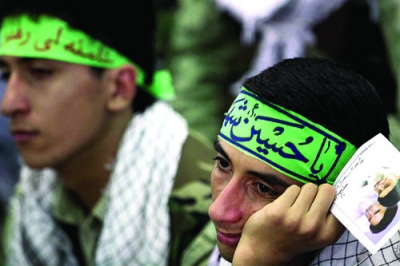
Members of the Basij listen as Ayatollah Ali Khamenei, Iran’s supreme leader, marks the thirtieth anniversary in 2009 of the militia’s formation. Clashing interpretations of the Islamic Republic’s revolution, which was democratic in nature and aspiration, mean that the mullahs and the secular authorities continue vying for supreme power.
But Khamenei, meanwhile, developed an increasing appetite to concentrate more and more absolute power in his own hands. His supporters have ramped up attacks on the president for a long litany of alleged sins: advocating Iranian nationalism, lauding past kings (particularly Cyrus, praised in the Bible for freeing Jews from their Babylonian captivity), and celebrating the Persian new year, Nowruz, an act considered pagan by the pious and by Khamenei himself. Some accused Ahmadinejad of secretly negotiating with the United States and European powers, even conspiring with them against Khamenei.
In spite of the propaganda blitzkrieg, Ahmadinejad has yet to submit to his opponents’ most important demand, to dismiss his closest ally and confidant, Esfandiar Mashaei. Accused of financial corruption, moral turpitude, and unsavory conjurations, Mashaei is at the heart of the controversy. The two men are old friends and spiritual soul mates. Mashaei is also the father-in-law of one of Ahmadinejad’s sons.
Ahmadinejad has also kept in place another controversial deputy president accused of massive financial malfeasance. Moreover, he continues to defy the parliament on key issues, including his decision to merge ministries against their will. He has fired key Khamenei supporters (at least one of whom, the foreign minister, has been pushed back into office by the supreme leader). Even more critical, Ahmadinejad declared he would make himself acting minister of oil, a key position in a regime that survives on petroleum-funded patronage and where the government budget is more than 80 percent dependent on oil and gas revenues. And although the Guardian Council declared the decision to play the dual roles illegal, Ahmadinejad refused to reconsider, relenting only after the Majlis sent the case to court. He still is effectively in control of the oil ministry.
Khamenei’s supporters have offered a variety of theories to justify the supreme leader’s encroachment on executive power. A few say that the supreme leader enjoys “divine legitimacy” and speaks for God, and thus his words and wishes trump any law or tradition. One sycophantic mullah—a Friday-prayer leader in the holy city of Meshed—declared that “all the zeros in the number of votes a person gets” mean nothing until the supreme leader “validates” the vote and appoints the man president. Another claimed that challenging Khamenei’s words is tantamount to shirk, or heresy. Yet another argued that Khamenei was not elected to his post by the eighty-six-man body of experts, as stipulated by the constitution, but was “discovered” by them, clearly implying that only God, having imbued him with his saintly sagacity, can “undiscover” him. In short, the crisis is being used to jettison any vestiges of republicanism left in the constitution.
There is a common thread in these struggles: Ahmadinejad is seen as trying to distance himself from the clergy and endear himself to the moderate middle classes. While the president’s hope that the democratic opposition, or the wealthy and erudite, will coalesce around him might indicate he’s gone off the deep end, an outside observer can acknowledge in his efforts the continuing appeal of democratic ideals.
IMMUNE TO THE “ARAB SPRING”?
The world has rightly rejoiced at a much-belated Arab spring (a spring that saw its first blossoms in Tehran in June 2009). In Iran, meanwhile, Khamenei and his allies have been methodically, ruthlessly establishing the planet’s most unabashed theocratic despotism. Just as the rise of Khomeini in 1979 bred radical Islam, the success of Khamenei in his new antidemocratic project can only reinvigorate the now-declining forces of that radicalism. Without a democratic Iran, the Arab spring is unlikely to change the face of the region.
And the more isolated the regime becomes, the more intensely it needs to be at least a virtual nuclear state—one that has demonstrated the technological capacity to build a bomb, should it make the political decision to do so—and use this status to deter outside pressure and domestic challenges to its power. It may be that only a democratic government can solve Iran’s nuclear issue, but the road to this transition is treacherous. For although a war of attrition between the president and the supreme leader opens the possibility of a more open political system, it is also highly likely to beget a kind of Bonapartist resolution in which an entrenched absolutist regime, led by the Republican Guards, is the result.
Indeed, the Iranian leadership has long followed the advice in Henry IV that “giddy minds” must be kept busy with foreign wars. The regime’s Achilles’ heel is the economy, and as long as it faces domestic pressures it will be motivated to be belligerent toward the outside world and repressive at home. Almost a million young men and women join the labor force each year. Iran faces an uphill battle in its attempt to end subsidies on basic commodities without serious social dislocation. Until now, leaders have navigated their way out of disruption by giving cash payments to the poorest people. Most economists predict that the current pattern is untenable, and the false quiet of today presages a storm tomorrow.
As the economic situation worsens, Khamenei and his allies in the IRGC have the perfect opportunity to confront Ahmadinejad and wrest him from power, whether figuratively or literally.
The blame game has already begun. A remarkable series of revelations and claims about Ahmadinejad’s mismanagement of the economy has come forth. Government sources have declared the real unemployment rate to be above 30 percent, with annual inflation for basic foodstuffs running at 25 percent. With hyperinflation on the horizon, Depression-era unemployment numbers already a reality, and the democratic winds in the region continuing unabated, Khamenei might need a sacrificial lamb.
The fight between the ambitious, weakened president and the embittered, isolated Khamenei is both a symptom of a structural crisis and an added ingredient for its continuation. One can be strategically optimistic about Iran’s future but tactically pessimistic about its immediate fate.








